Systems for automatic lighting control of buildings
Electricity consumption for lighting purposes can be significantly reduced by achieving optimal operation of the lighting installation at any given time.
To achieve the most complete and accurate accounting of the presence of daylight, as well as accounting for the presence of people in the room, you can use means of automatic lighting management (LMS)... Lighting is controlled in two main ways: turning off all or part of the lighting fixtures (discreet control) and a smooth change in the power of the lighting fixtures (the same for everyone or for an individual).
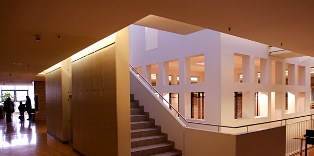
YES discrete lighting control systems mainly include various photo relays (photo machines) and timers. The principle of operation of the first one is based on switching the load on and off via signals from an external ambient light sensor.
The latter switch the lighting load, depending on the time of day, according to a preset program.
 Discrete lighting control systems also include machines equipped with presence sensors... They turn off the lights in the room after a certain period of time, after the latter is removed from it. This is the most economical type of discrete control systems, but the side effects of their use include a possible reduction in lamp life due to frequent switching on and off.
Discrete lighting control systems also include machines equipped with presence sensors... They turn off the lights in the room after a certain period of time, after the latter is removed from it. This is the most economical type of discrete control systems, but the side effects of their use include a possible reduction in lamp life due to frequent switching on and off.
Systems for continuous control of lighting power, its structure is a little more complicated. The principle of their work is explained in the figure.
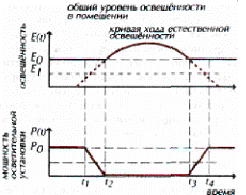
The principle of operation of the continuous lighting control system
Recently, many foreign companies have mastered the production of indoor lighting control automation equipment. Modern lighting control systems combine significant capabilities saving energy with maximum convenience for the user.
The main functions of automated lighting control systems
Automated lighting control systems intended for use in public buildings perform the following functions typical of this type of product:
Precise maintenance of artificial light in the room at a given level... This is achieved by introducing a photocell into the lighting control system, which is inside the room and controls the lighting created by the lighting installation. This feature alone saves energy by cutting off the so-called "excess light".
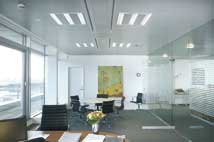 Considering the natural light in the room... Despite the presence of natural light in the majority of the rooms during the day, the power of the lighting installation is calculated without taking it into account.
Considering the natural light in the room... Despite the presence of natural light in the majority of the rooms during the day, the power of the lighting installation is calculated without taking it into account.
If you keep the lighting created together by the lighting installation and natural light at a given level, then you can further reduce the output of the lighting installation at any point in time.
At certain times of the year and times of the day, it is even possible to use only natural light. This function can be performed with the same photocell as in the previous case, provided that it observes full (natural + artificial) lighting. In this case, the energy saving can be 20 - 40%.
Counting the time of day and day of the week. Additional energy savings in lighting can be achieved by turning off the lighting installation at certain times of the day, as well as during weekends and holidays. This measure allows you to effectively fight the forgetfulness of people who do not turn off the lights at their workplace before leaving. For its implementation, an automated lighting control system must be equipped with its own real-time clock.
Detection of the presence of people in the room. When you equip a lighting control system with a presence sensor, you can turn the lights on and off depending on whether there are people in the room. This function allows you to use energy in the most optimal way, but its use is far from justified in all rooms. In some cases, it can even shorten the life of the lighting equipment and create an unpleasant impression during operation.
Energy savings obtained by turning off lighting fixtures according to timer signals and presence sensors is 10 — 25%.
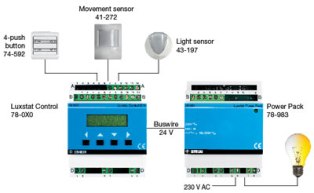
Remote wireless control of the lighting system... Although this function is not automated, it is often present in automated lighting control systems due to the fact that its implementation based on the electronics of the lighting control system is very simple, and the function itself adds significantly convenience to the management of a lighting installation.
The methods of direct control of the lighting installation are discrete switching on / off of all or part of the lamps according to the commands of the control signals, as well as stepwise or gradual reduction of the lighting power depending on the same signals.
Due to the fact that modern adjustable electronic ballasts have a zero lower adjustment threshold; in modern automated lighting control systems, a combination of smooth adjustment to the lower threshold is used, with complete switching off of the lamps in the luminaires when it is reached.
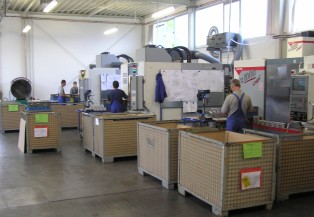
Classification of automatic lighting control systems
Automatic lighting control systems can be conditionally divided into two main classes — so-called local and centralized.
Local systems usually control only one group of luminaires, while centralized systems allow the connection of an almost infinite number of separately controlled groups of luminaires.
In turn, according to the control area covered, local systems can be divided into «lighting control systems» and «room lighting control systems», and centralized - into specialized (only for lighting control) and with general purpose (for control of all engineering systems of a building — heating, air conditioning, fire and burglar alarms, etc.).
Local lighting control systems
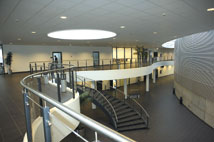 Local "light control systems" require no additional wiring in most cases, and sometimes even reduce the need for wiring. Structurally, they are carried out in small housings, fixed directly to the light fixture or to the bulb of one of the lamps. All sensors, as a rule, represent an electronic device, in turn, built into the body of the system itself.
Local "light control systems" require no additional wiring in most cases, and sometimes even reduce the need for wiring. Structurally, they are carried out in small housings, fixed directly to the light fixture or to the bulb of one of the lamps. All sensors, as a rule, represent an electronic device, in turn, built into the body of the system itself.
Often, lighting fixtures equipped with sensors exchange information with each other along the paths of the electrical network. Therefore, even if there is only one person left in the building, the lights in their path will remain on.
Centralized lighting control systems
Centralized lighting control systems, which most fully correspond to the name "intelligent", are built on the basis of microprocessors, which provide the possibility of almost simultaneous multivariate control of a significant (up to several hundred) number of lamps. Such systems can be used either to control lighting alone or also to interact with other building systems (eg the telephone network, security systems, ventilation, heating and solar protection).
Centralized systems also issue control signals to lighting fixtures based on signals from local sensors. However, the conversion of signals takes place in one (central) node, which provides additional options for manual control of the building's lighting. At the same time, manual change of the system operation algorithm is greatly simplified.
In centralized remote or automatic lighting control systems, power to the control circuits is enabled from the line supplying the lighting.
For rooms with areas with different natural lighting conditions, task lighting control should ensure that lamps are turned on and off in groups or rows as the natural lighting of the rooms changes.
The existing range of automated lighting management systems (LMS) is divided into three classes:
1) Luminaire control system — the simplest system of small dimensions, which is structurally part of the lighting unit and controls only or one group of several nearby lighting units.
2) OMS premises — an independent system that controls one or several groups of lighting fixtures in one or several premises.
3) LMS building — a centralized computer control system covering lighting and other systems of an entire building or group of buildings.
Most manufacturing companies lighting management systems (LMS) of lighting fixtures, these systems are produced as separate units that can be built into lighting fixtures of different types.
The undoubted advantage of OMS lighting fixtures is their ease of installation and operation, as well as reliability.OMS that do not require a power supply are particularly reliable, as OMS power supplies and power-consuming chips are the most susceptible to failure.
However, if it is necessary to control the lighting installations of large rooms or, for example, the task is the individual control of all the lighting fixtures in the room, the LMS of the lighting fixtures turns out to be a rather expensive control tool, since they require the installation of one LMS per lighting fixture. In this case, it is more convenient to use OMS on premises that contain fewer electronic components than required in the previous case, and are therefore cheaper.
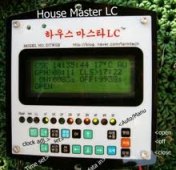 Room OMS are units placed behind suspended ceilings or structurally embedded in electrical distribution boards. Systems of this type, as a rule, perform a single function or a fixed set of functions, the choice between which is made by permutation of switches on the body or on the remote control of the system.
Room OMS are units placed behind suspended ceilings or structurally embedded in electrical distribution boards. Systems of this type, as a rule, perform a single function or a fixed set of functions, the choice between which is made by permutation of switches on the body or on the remote control of the system.
Such OMS are relatively easy to manufacture and are usually built on discrete logic chips. OMS room sensors are always remote, they must be placed in a room with controlled lighting installations and require special wiring to them, which is a certain practical inconvenience.
Article author: Sun Cheek
